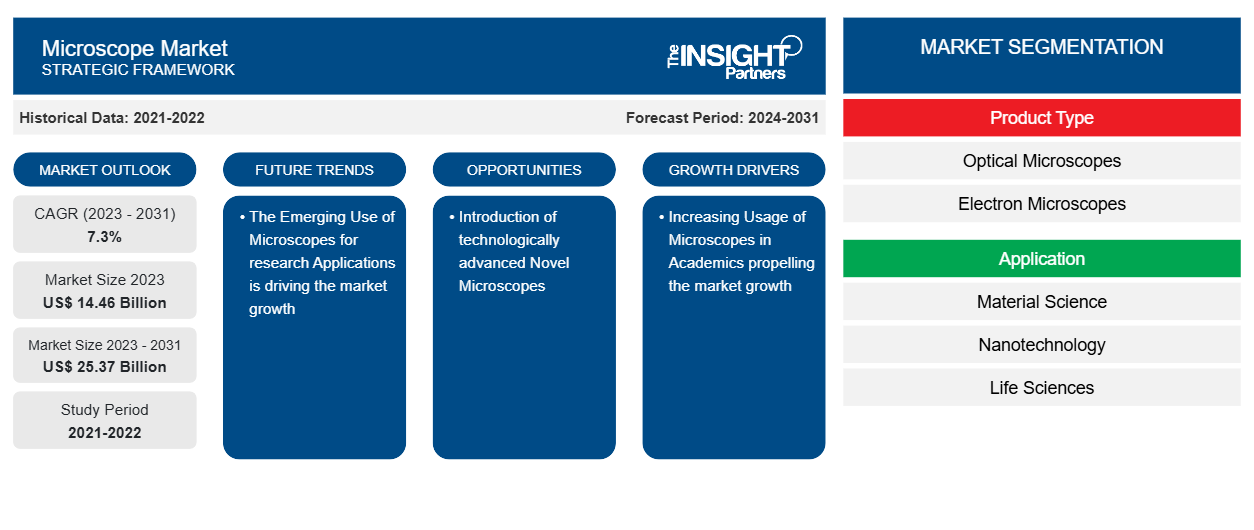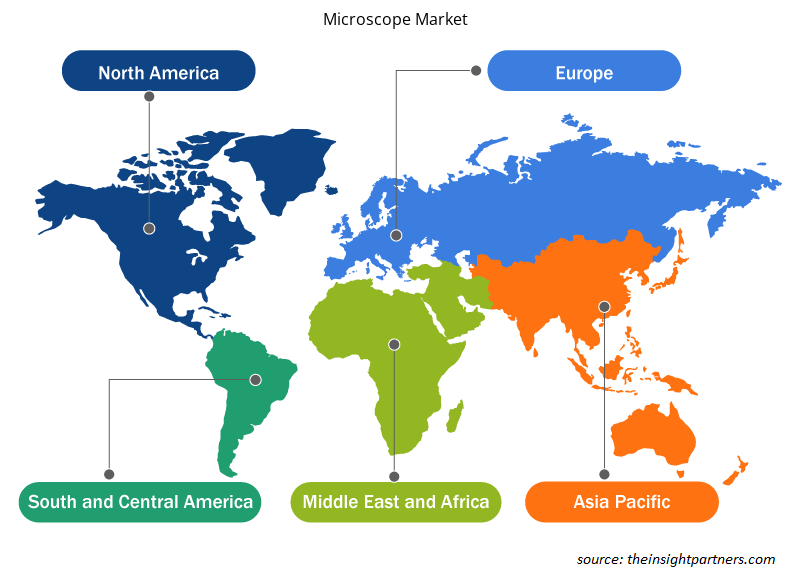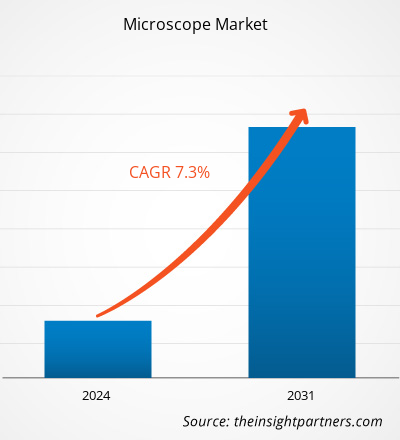Der Mikroskopmarkt wird voraussichtlich von 2.657,70 Millionen US-Dollar im Jahr 2024 auf 4.034,79 Millionen US-Dollar im Jahr 2031 anwachsen. Für den Zeitraum 2025–2031 wird eine durchschnittliche jährliche Wachstumsrate (CAGR) von 6,20 % erwartet. Die zunehmende Integration von KI und Remote-Technologien in Mikroskope dürfte in den kommenden Jahren neue Markttrends mit sich bringen.
Mikroskop-Marktanalyse
Die zunehmenden Anwendungen in Forschung und Gesundheitswesen sowie die steigenden Mittel für Forschung und Entwicklung beschleunigen das Marktwachstum. Forschungs- und Gesundheitsanwendungen treiben die Nachfrage nach fortschrittlichen und spezialisierten Mikroskopielösungen voran. Mikroskope spielen eine entscheidende Rolle bei der Beobachtung und Analyse biologischer Proben auf zellulärer und molekularer Ebene. In der Krebsforschung werden beispielsweise hochauflösende Mikroskopietechniken wie die Konfokal- und Fluoreszenzmikroskopie umfassend eingesetzt, um Tumormorphologie, Zellverhalten und molekulare Interaktionen zu untersuchen und so zielgerichtete Therapien zu entwickeln. Mikroskopie ist in der Pathologie und Diagnostik unverzichtbar, insbesondere für die Untersuchung von Blutproben, Gewebebiopsien und Infektionserregern. Die zunehmende Verbreitung chronischer Krankheiten wie Diabetes und Krebs sowie von Infektionskrankheiten wie Tuberkulose hat den Bedarf an präzisen Diagnoseinstrumenten geschaffen. Beispielsweise werden digitale Pathologiemikroskope mit KI-gestützter Bildanalyse zunehmend in Krankenhäusern eingesetzt, um die diagnostische Genauigkeit und die Effizienz der Arbeitsabläufe zu verbessern.
Im Mikroskopmarkt wurden verschiedene Produkteinführungen durchgeführt . So kündigte Evident im Mai 2025 die Veröffentlichung zweier neuer konfokaler Spinning-Disk-Mikroskope an, des IXplore IX85 SpinXL und des IXplore IX85 SpinSR. Basierend auf Evidents neuem automatisierten invertierten Mikroskopsystem IXplore IX85 erweitern das IX85 SpinXL und das IX85 SpinSR die Plattform um leistungsstarke neue Technologien und erweitern so die Möglichkeiten der Forscher, Lebendzellbilder zu erfassen und zu entdecken.
Marktübersicht für Mikroskope
Mikroskopie ist in der medizinischen Aus- und Weiterbildung von entscheidender Bedeutung. Sie ermöglicht Studierenden und Fachkräften den Erwerb praktischer Fähigkeiten und ein tieferes Verständnis der menschlichen Anatomie und Pathologie. Bildungseinrichtungen investieren in interaktive und digitale Mikroskopieplattformen, die virtuelle Mikroskopie und Fernunterricht ermöglichen. Darüber hinaus sind Mikroskope in der Veterinärmedizin, den Umweltwissenschaften und der Agrarforschung unverzichtbar, um die Tiergesundheit zu überwachen , Umweltschadstoffe zu erkennen und Ernteerträge zu steigern. Beispielsweise wird die Elektronenmikroskopie häufig in der Pflanzenpathologie eingesetzt, um Viren und Pilze zu untersuchen, die Nutzpflanzen befallen, und so die Entwicklung krankheitsresistenter Pflanzensorten zu fördern. Der wachsende Anwendungsbereich in Forschung und Gesundheitswesen sowie der technologische Fortschritt in der Mikroskopie treiben daher das Wachstum des Mikroskopmarktes voran.
Sie erhalten kostenlos Anpassungen an jedem Bericht, einschließlich Teilen dieses Berichts oder einer Analyse auf Länderebene, eines Excel-Datenpakets sowie tolle Angebote und Rabatte für Start-ups und Universitäten
Mikroskopmarkt: Strategische Einblicke

-
Informieren Sie sich über die wichtigsten Markttrends in diesem Bericht.Dieses KOSTENLOSE Beispiel umfasst Datenanalysen, von Markttrends bis hin zu Schätzungen und Prognosen.
Treiber und Chancen des Mikroskopmarktes
Steigende Forschungsfinanzierung stärkt das Marktwachstum
Das Programm Horizont Europa der Europäischen Union, das für den Zeitraum 2021–2027 über ein Budget von über 107,94 Milliarden US-Dollar (93,5 Milliarden Euro) verfügt, unterstützt eine breite Palette wissenschaftlicher Initiativen. Diese massiven Investitionen tragen direkt zum wachsenden Mikroskopmarkt bei, da die Institutionen in moderne Geräte investieren, um ihre Forschungsziele zu erreichen. Darüber hinaus tragen Investitionen des privaten Sektors, darunter Pharmaunternehmen und Biotech-Startups, zur steigenden Nachfrage nach Mikroskopen bei. Beispielsweise beruht die Arzneimittelforschung auf Fluoreszenz- und Elektronenmikroskopie, um Arzneimittel-Ziel-Interaktionen auf zellulärer Ebene zu visualisieren. Laut der International Federation of Pharmaceutical Manufacturers and Associations erreichten die weltweiten Ausgaben für pharmazeutische Forschung und Entwicklung im Jahr 2021 276 Milliarden US-Dollar, wobei ein beträchtlicher Anteil für Forschung mit Mikroskopietechnologien bestimmt war. Eine Erhöhung der Forschungsgelder ermöglicht es wissenschaftlichen Institutionen daher, fortschrittliche Mikroskopiegeräte anzuschaffen und zu modernisieren, und fördert das Wachstum des Mikroskopmarktes.
Steigende Produktneueinführungen durch Marktteilnehmer schaffen Chancen
Die Präsenz verschiedener Marktteilnehmer im Mikroskopmarkt konzentriert sich auf Produkteinführungen, die bei Diagnose, Beobachtung und anderen Anwendungen in der Life-Science-Branche helfen. Im Mikroskopmarkt gab es bereits verschiedene Produkteinführungen. Einige davon sind nachfolgend aufgeführt:
- Im November 2024 brachte Evident das automatisierte inverse Mikroskopsystem IXplore IX85 auf den Markt. Mit einer Sehfeldzahl (FN) von 26,5 mm und neuen, fortschrittlichen Bildgebungswerkzeugen für präzise und klare Ergebnisse ermöglicht dieses neue System Forschern, mehr Daten zu erfassen und schneller als je zuvor neue Erkenntnisse zu gewinnen. Es bietet zudem ein unübertroffenes Maß an Anpassungsmöglichkeiten, sodass Anwender eine leistungsstarke Bildgebungs- und intelligente Plattform entwickeln oder bauen können, die ihren Anforderungen entspricht.
- Im September 2024 brachte Nikon das digitale Bildmikroskop ECLIPSE Ui Ver. 1.3 für den medizinischen Einsatz auf den Markt. Es ist mit drei neuen Funktionen ausgestattet, die dazu beitragen, die pathologische Beobachtung zu optimieren und zu verhindern, dass Läsionsstellen übersehen werden.
Segmentierungsanalyse des Mikroskopmarktberichts
Wichtige Segmente, die zur Ableitung der Mikroskop-Marktanalyse beigetragen haben, sind Technologie, Endbenutzer und Geografie.
- Basierend auf der Technologie ist der Mikroskopmarkt in optische Mikroskope, Elektronenmikroskope, Rasterkraftmikroskope und weitere segmentiert. Das Segment der optischen Mikroskope hatte 2024 den größten Marktanteil und wird zwischen 2025 und 2031 voraussichtlich eine signifikante jährliche Wachstumsrate verzeichnen.
- Der Mikroskopmarkt ist hinsichtlich der Endnutzer segmentiert in Hochschulen und Forschungsinstitute, Pharma- und Biopharmaunternehmen, Diagnosezentren und weitere. Das Segment der Pharma- und Biopharmaunternehmen hielt 2024 den größten Anteil am Mikroskopmarkt und wird zwischen 2025 und 2031 voraussichtlich eine signifikante jährliche Wachstumsrate verzeichnen.
Mikroskop-Marktanteilsanalyse nach Geografie
Der geografische Umfang des Mikroskopmarktberichts ist hauptsächlich in fünf Hauptregionen unterteilt: Nordamerika, Europa, Asien-Pazifik, Naher Osten und Afrika sowie Süd- und Mittelamerika. Nordamerika dominierte den Markt im Jahr 2024. Der Mikroskopmarkt in Nordamerika ist in die USA, Kanada und Mexiko segmentiert. Die Präsenz einer großen Anzahl akademischer Institute, einer fortschrittlichen Gesundheitsinfrastruktur sowie Forschungs- und Entwicklungsinstituten treibt das Wachstum des Mikroskopmarktes voran. Rasche Innovationen in der Mikroskopietechnologie, wie beispielsweise Superauflösungs- und Digitalmikroskope, bieten höhere Präzision und verbesserte Bildgebungsmöglichkeiten. Diese Innovationen erhöhen die Vielseitigkeit und Zugänglichkeit von Mikroskopen für ein breiteres Anwenderspektrum. Darüber hinaus fördert die starke Präsenz führender biotechnologischer, pharmazeutischer und akademischer Forschungseinrichtungen in der Region die konstante Nachfrage nach fortschrittlichen Mikroskopen zur Unterstützung der Arzneimittelforschung, der Zellbiologie und der Genforschung. Regierungen und private Organisationen in den USA und Kanada investieren kontinuierlich in Forschungs- und Entwicklungsaktivitäten und tragen so zu einem günstigen Umfeld für wissenschaftliche Forschung und die Beschaffung von Ausrüstung bei.
Regionale Einblicke in den Mikroskopmarkt
Die Analysten von Insight Partners haben die regionalen Trends und Faktoren, die den Mikroskopmarkt im Prognosezeitraum beeinflussen, ausführlich erläutert. Dieser Abschnitt behandelt außerdem die Marktsegmente und die geografische Lage von Mikroskopen in Nordamerika, Europa, Asien-Pazifik, dem Nahen Osten und Afrika sowie Süd- und Mittelamerika.

- Erhalten Sie regionale Daten zum Mikroskopmarkt
Umfang des Mikroskop-Marktberichts
| Berichtsattribut | Details |
|---|---|
| Marktgröße im Jahr 2024 | 2.657,70 Millionen US-Dollar |
| Marktgröße bis 2031 | 4.034,79 Millionen US-Dollar |
| Globale CAGR (2025 – 2031) | 6,2 % |
| Historische Daten | 2021-2023 |
| Prognosezeitraum | 2025–2031 |
| Abgedeckte Segmente |
Nach Technologie
|
| Abgedeckte Regionen und Länder |
Nordamerika
|
| Marktführer und wichtige Unternehmensprofile |
|
Dichte der Marktteilnehmer im Mikroskopbereich: Auswirkungen auf die Geschäftsdynamik verstehen
Der Mikroskopmarkt wächst rasant. Die steigende Nachfrage der Endnutzer ist auf Faktoren wie veränderte Verbraucherpräferenzen, technologische Fortschritte und ein stärkeres Bewusstsein für die Produktvorteile zurückzuführen. Mit der steigenden Nachfrage erweitern Unternehmen ihr Angebot, entwickeln Innovationen, um den Bedürfnissen der Verbraucher gerecht zu werden, und nutzen neue Trends, was das Marktwachstum weiter ankurbelt.
Die Marktteilnehmerdichte beschreibt die Verteilung der in einem bestimmten Markt oder einer bestimmten Branche tätigen Unternehmen. Sie gibt an, wie viele Wettbewerber (Marktteilnehmer) in einem bestimmten Marktraum im Verhältnis zu dessen Größe oder Gesamtmarktwert präsent sind.
Die wichtigsten auf dem Mikroskopmarkt tätigen Unternehmen sind:
- CARL ZEISS AG;
- Bruker Corporation;
- Leica Microsystems;
- Nikon Corporation;
- Thermo Fischer Scientific Inc.;
- Olympus Corporation;
Haftungsausschluss : Die oben aufgeführten Unternehmen sind nicht in einer bestimmten Reihenfolge aufgeführt.

- Überblick über die wichtigsten Akteure auf dem Mikroskopmarkt
Neuigkeiten und aktuelle Entwicklungen auf dem Mikroskopmarkt
Der Mikroskopmarkt wird durch die Erhebung qualitativer und quantitativer Daten aus Primär- und Sekundärforschung bewertet, die wichtige Unternehmenspublikationen, Verbandsdaten und Datenbanken einbeziehen. Die wichtigsten Marktentwicklungen sind nachstehend aufgeführt:
- Leica Microsystems hat die Visoria-Serie aufrechter Mikroskope auf den Markt gebracht, um Pathologen, Qualitätsmanagern und Forschern die Effizienz und den Komfort routinemäßiger Mikroskopiearbeiten zu verbessern. (Quelle: Leica Microsystems, Unternehmenswebsite, Mai 2025)
- ZEISS erweitert sein Portfolio in der optischen und taktilen Messtechnik mit der Einführung von ZEISS O-INSPECT duo. Diese innovative Lösung kombiniert präzise Messtechnik mit hochauflösender mikroskopischer Inspektion und ermöglicht so die Prüfung großer und kleiner Bauteile in einem einzigen Gerät. (Quelle: ZEISS Carls, Unternehmenswebsite, März 2024).
Marktbericht zu Mikroskopen: Umfang und Ergebnisse
Der Bericht „Marktgröße und Prognose für Mikroskope (2021–2031)“ bietet eine detaillierte Analyse des Marktes, die die folgenden Bereiche abdeckt:
- Mikroskop-Marktgröße und -prognose auf globaler, regionaler und Länderebene für alle wichtigen Marktsegmente, die im Rahmen des Geltungsbereichs abgedeckt sind
- Mikroskop-Markttrends sowie Marktdynamiken wie Treiber, Einschränkungen und wichtige Chancen
- Detaillierte PEST- und SWOT-Analyse
- Marktanalyse für Mikroskope, die wichtige Markttrends, globale und regionale Rahmenbedingungen, wichtige Akteure, Vorschriften und aktuelle Marktentwicklungen umfasst.
- Branchenlandschafts- und Wettbewerbsanalyse mit Marktkonzentration, Heatmap-Analyse, prominenten Akteuren und jüngsten Entwicklungen für den Mikroskopmarkt
- Detaillierte Firmenprofile
- Historische Analyse (2 Jahre), Basisjahr, Prognose (7 Jahre) mit CAGR
- PEST- und SWOT-Analyse
- Marktgröße Wert/Volumen – Global, Regional, Land
- Branchen- und Wettbewerbslandschaft
- Excel-Datensatz
Aktuelle Berichte
Verwandte Berichte
Erfahrungsberichte
Grund zum Kauf
- Fundierte Entscheidungsfindung
- Marktdynamik verstehen
- Wettbewerbsanalyse
- Kundeneinblicke
- Marktprognosen
- Risikominimierung
- Strategische Planung
- Investitionsbegründung
- Identifizierung neuer Märkte
- Verbesserung von Marketingstrategien
- Steigerung der Betriebseffizienz
- Anpassung an regulatorische Trends






















 Kostenlose Probe anfordern für - Mikroskopmarkt
Kostenlose Probe anfordern für - Mikroskopmarkt